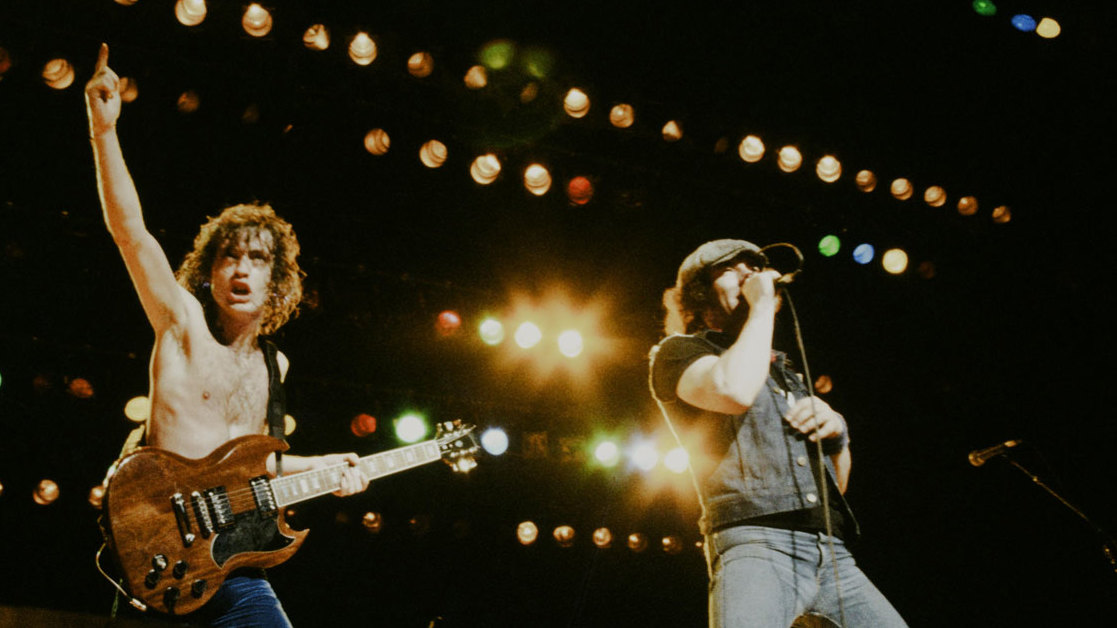As the legendary American author F. Scott Fitzgerald once almost said, there are no second acts in rock star lives. But the true history of rock is a rollercoaster ride of peaks and slumps, rebirths and reinventions. Ever since Elvis Presley shook off the shackles of Hollywood, dug out his old black leathers and reactivated his ailing career with the electrifying 1968 Comeback Special, rockers have been rebranding and resurging, sometimes even cheating the Grim Reaper himself. Here, Classic Rock counts down 14 of rock’s greatest resurrections…
AC/DC
Most groups would take the death of their lead singer as a potentially fatal body blow. AC/DC briefly considered disbanding after Bon Scott died of alcohol poisoning in February 1980, but opted instead to recruit new frontman Brian Johnson and finish the album that Scott had just started working on, Back in Black. It went on to sell a phenomenal 50 million copies, a career-topping smash hit with a pounding, screeching, stripped-down, balls-out sound that transformed the Anglo-Australian schoolboy impersonators into evergreen stadium-rock fixtures. Thirty-six years later, they’d replace Johnson himself with Axl Rose – another decision that appears to have paid off in spades.
Kicked out of Black Sabbath in 1979 for unreliability and substance abuse problems, Ozzy laid low in Los Angeles. But his future wife Sharon picked him off the floor, steered him towards the first of a dozen visits to rehab, and helped him assemble a new band, which he emphatically refused to call Son of Sabbath. His 1980 debut solo album, Blizzard of Ozz, sold four million copies and rebranded the bat-chomping Charlie Sheen of hard rock from broken-down drug casualty to perennial poster boy for success through excess. Winning!
Tina Turner
Divorced in 1978 after suffering years of drug-fuelled domestic violence, Tina Turner walked away from control-freak husband Ike with huge debts and minimal career prospects. After a run of flop albums and low-key collaborations failed to find an audience, David Bowie helped broker a new deal with the Capitol label, which led to Turner’s hit-packed 1984 comeback Private Dancer. The album sold a staggering 20 million copies, earned four Grammy awards and rocketed the big-haired R&B diva into the superstar premiere league, proving the old adage that success is the best revenge.
Heart
After a solid commercial run in the late 1970s, the folky hard rockers led by Seattle siblings Ann and Nancy Wilson found their star in decline. Their solution involved changing record labels, bringing in outside songwriters, and intensive deployment of weapons-grade hairspray. Thanks to a glossy hair-metal makeover, Heart were reborn as an AOR hit machine on their self-titled 1985 album, a US chart-topper loaded with MTV-friendly power ballads. Ditching their acoustic roots for a slick new look and sound, they enjoyed a further run of multi-platinum albums, scoring a UK Number 3 with Brigade in 1990.
Aerosmith
Torn apart by drug addiction and internal friction, 1970s blues-rock survivors Aerosmith seemed like a spent force by the early 1980s. But a new record deal with Geffen, a therapautic trip to rehab, and an inspired crossover remake of their own hard-rock classic Walk This Way featuring hip-hop stars Run DMC led to a blazing rebirth in 1986. Working with outside songwriters for the first time, Steven Tyler and Joe Perry cleaned up their act for a glorious run of MTV-friendly hit singles and multi-platinum albums, beginning with the seven-million-selling Permanent Vacation in 1987.
Whitesnake
Former Deep Purple singer David Coverdale hit a wobbly patch in the early 1980s, drifting away from his blues-rock roots with a run of commercially lukewarm albums. He finally sacked his entire band on the eve of releasing Whitesnake’s self-titled 1987 album, which embraced a super-glossy new poodle-haired glam-metal sound. The album sold over nine million copies partly on the back of its chart-topping mega-hits Here I Go Again and Is This Love. Coverdale’s future wife Tawny Kitean, who co-starred in both videos, may have been a factor in Whitesnake’s most successful album ever.
Lynyrd Skynyrd
The Southern Rock overlords were riding high in late 1977, with their million-selling Street Survivors album and a huge arena tour both looming. But a tragic plane crash on October 20 killed singer Ronnie Van Zant, guitarist Steve Gaines and backup singer Cassie Gaines, while several other band members suffered serious injuries. Dormant for a decade, the shattered survivors reformed in 1987 with Van Zant’s brother Johnny on vocals, a one-off tribute tour that grew into a Lazarus-like rebirth that continues to this day. With an ever-evolving line-up, Skynyrd’s two most recent albums were their highest-charting releases since their pre-crash peak.
Johnny Cash
He may have been notorious for playing behind bars, but the Man In Black couldn’t get arrested by the late 1980s. Dropped by his long-time label Columbia, Cash’s career was in freefall until Rick Rubin signed him to his left-field label American Recordings and encouraged him to cover contemporary rock songs in raw, gravel-voiced, stripped-down arrangements. Beginning in 1994, Cash’s majestic run of final albums earned him a new audience of younger fans, a brace of Grammy awards and a show-stopping appearance at Glastonbury.
Foo Fighters
As drummer with the most iconic punk supergroup of your generation, what are your options after your charismatic lead singer and principle songwriter commits suicide? Pretty limited. Dave Grohl could have cynically milked Nirvana’s tormented legacy for maximum profit, or quietly retired to count his money. Instead he boldly stepped into the spotlight, using Kurt Cobain’s loss as the unlikely launchpad for one of the most beloved, consistently uplifting, stadium-sized rock bands of the last 20 years. Triumph from tragedy.
Iron Maiden
There was little love lost when Bruce Dickinson quit Iron Maiden in 1993. “Good fucking riddance!” Nicko McBrain announced during the outgoing frontman’s farewell tour. “I can’t wait to get to the end of this tour and find a new singer.” But with former Wolfsbane vocalist Blaze Bayley on board, the NWOBHM titans soon slumped into critical and commercial decline. Sacking Bayley in 1999, the band’s founding guitarist Steve Harris agreed a grudging truce with Dickinson and together they began restoring the battered Maiden brand with Brave New World, the first in a stream of million-selling albums backed up by spectacular, record-breaking, marathon world tours.
Leonard Cohen
After a decade of semi-retirement, including long retreats in a Zen Buddhist monastery, a 74-year-old Cohen grudgingly returned to live performance in 2008 to replace $5 million in savings stolen by his former manager. His comeback may have been financially driven but the shows proved to be magical, rapturously received celebrations of an Old Master’s talent. The reclusive Canadian crooner replenished his missing funds but continued with his sell-out world tour, playing to his biggest ever audiences. In 2012, he released the highest charting album of his career, Old Ideas.
Wilko Johnson
Struck down with apparently terminal cancer in early 2013, the former Doctor Feelgood guitarist experienced a strangely euphoric sense of calm before cheerfully embarking on a farewell tour. But his condition turned out to be misdiagnosed. In October 2014, Johnson underwent major kill-or-cure surgery, with doctors removing a three-pound tumour: “the size of a baby!” he joked afterwards. This miraculous survival story cemented Johnson’s status as a much-loved national treasure and helped him score his highest-charting album for almost 40 years, the Roger Daltrey collaboration Going Back Home.
David Bowie
Keeping a low profile after his 2004 heart attack, Bowie spent almost a decade in silence as dark rumours about his health circulated. But in January 2013, in a genius piece of guerrilla marketing, he dropped a surprise new single, Where Are We Now? Both the single and its parent album The Next Day became his first chart-toppers in 20 years, paving the way for his record-breaking V&A exhibition David Bowie Is, his Broadway musical Lazarus and his magnificent 2016 farewell album, Blackstar. The tragedy of Bowie’s death earlier this year was offset by this glorious autumnal comeback, going out on a critical and commercial high.
Def Leppard
Driving on the A57 near Sheffield with girlfriend Miriam Barendsen on New Year’s Eve 1984/’85, Rick Allen lost control of his black 1984 Corvette Stingray and hit a brick wall. His seatbelt came undone and took off his left arm as the drummer was thrown through the sunroof. After being told he wouldn’t play again, Allen began a lengthy recovery programme that culminated in his return to the stage in August 1986. Next up? Hysteria.

